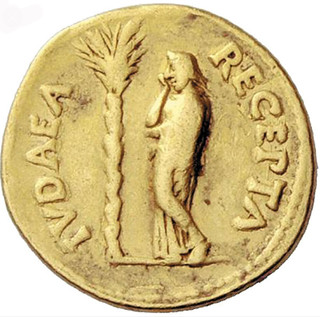
PREV ARTICLE
NEXT ARTICLE
FULL ISSUE
PREV FULL ISSUE
A REINTERPRETATION OF THE 'JUDEA RECEPTA' LEGENDA Jewish Press discusses historian Linda Zollschan reinterpretation of the 'Judea Recepta' coin legend. -Editor
"Until now, Judaea recepta was commonly interpreted either as meaning the recovery of Judaea or as an announcement of a return to the embrace of the [Roman] provincial system," writes Zollschan. "However, Judaea recepta indicates surrender, and the aureus with the legend Judaea recepta thus commemorates the Roman acceptance of the unconditional surrender of the Jewish rebels in Jerusalem." Previous scholars have suggested that the word recepta indicates a message of "recovered" or "recaptured" rather than "captured" and as such, underlines a message saying "rather than conquest by force, a return to the embrace of the provincial system." The historian then proposes her blockbuster challenge: "whether it is possible to accept that recepta carries that meaning, and therefore whether the aureus conveys the message of a gentler view of Rome's triumph over the rebels in the Jewish revolt. "The sheer number of coins relating to the end of the first Jewish revolt minted by the Flavians testifies to their use as ‘propaganda on an unprecedented scale' (Ostrowski 1999:154-155). "While the quantity of coins with the legend Iudaea capta minted in gold, silver and bronze during the reigns of Vespasian and his sons, Titus and Domitian, over a period of 16 years (Brin 1986:10) is vast, only a single find to date has yielded a coin with the legend Iudaea recepta. No other Roman victory produced a similarly large number of coins (TJC:185). They were minted in Rome and across the empire in Lyon, Judaea, Antioch, Tarraco in Spain and Commagene (present-day south-central Turkey). The coins were designed to send a warning made repeatedly to other parts of the empire not to attempt a revolt from Rome (Brin 1986:10). The victory over the Jews was presented as a world event and not as a local uprising, particularly as populations of Jews could be found in many areas of the empire (Overman 2003:216)." The Roman custom was that surrender was accomplished through a ritual act, Zollschan further explains, with a ceremony that took the form of verbal questions and responses. Only after hearing an affirmative answer did the representative of Rome legally complete the ritual by saying "at ego recipio" (and so I accept [it], meaning the surrender). To read the complete article, see:
Found via The Explorator newsletter. To subscribe to Explorator, send a blank email message to:
 Wayne Homren, Editor The Numismatic Bibliomania Society is a non-profit organization promoting numismatic literature. See our web site at coinbooks.org. To submit items for publication in The E-Sylum, write to the Editor at this address: whomren@gmail.com To subscribe go to: https://my.binhost.com/lists/listinfo/esylum All Rights Reserved. NBS Home Page Contact the NBS webmaster 
|
